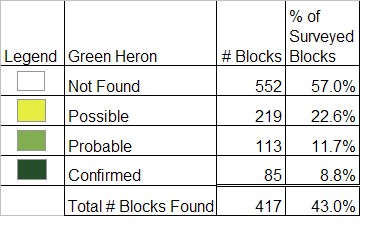Breeding Bird Atlases (BBA)
Find a Bird - BBA1
Breeding Bird Atlas 1 Species Accounts
Green Heron
Butorides virescens
Egg Dates
early May to early July
Number of Broods
one; may re-lay if first attempt fails.

One of the most cosmopolitan heron species in the world, the Green Heron is widely distributed in Massachusetts, although in most parts of the state it is uncommon. It frequents both inland wetlands and coastal marshes, and breeding was confirmed during the Atlas period from the Berkshires to Cape Cod and the Islands.
In eastern North America, Green Herons are highly migratory, arriving in Massachusetts around the last week of April. While loose breeding colonies are known for this species, most pairs are solitary nesters. These herons are highly vocal, and characteristically, when a bird is surprised at its roost, it will fly off with a loud skeow call, leaving a white line of excrement in its wake; hence the popular nickname “Chalk Line.” There is another seldom-heard croak made when the birds are very startled as well as an aggressive raah call. Green Herons often raise their crests and nervously flick their tails when they are excited.
The male Green Heron uses a series of ritualized displays to defend his nest site and attract a mate. In the “forward display,” the mouth lining is shown, while in the “snap display” (Palmer 1962), the bill is clicked and a bobbing motion is performed. Pursuit flights are common.
Nests may be on the ground or close to it but are usually built from 10 to 20 feet high in a bush or small tree on a stream bank or in the midst of a wetland. Some pairs may select an upland site. The heights of 7 Massachusetts nests ranged from 4 to 23 feet. Three were placed in unidentified shrubs, 1 in a lilac, 2 in a Red Maple, and 1 in a White Birch. Nestling dates in Massachusetts are reported for June and July (BOEM, CNR, Anderson, Parsons). Juveniles fledge at about 35 days of age.
The nest is ordinarily a flat, unlined platform of twigs 10 to 12 inches in diameter and is generally neither tightly constructed nor cup shaped so that the eggs often can be seen from below and appear to be in a precarious situation. Up to seven pale green or bluish eggs may be laid at 2-day intervals, with average clutches of four or five. Of 4 Massachusetts nests, 1 contained five eggs and 3 contained four eggs. Incubation is shared by both sexes for 21 to 25 days, and, because it begins with the first egg, hatching is asynchronous. Reported brood size in the Commonwealth ranged from three to five young per nest.
One and a half to two weeks after hatching, the young begin to leave the nest and climb on nearby branches and can scramble out of reach when an intruder climbs the nest tree. They are also good swimmers, a feature that may save their lives if they fall into open water. One other survival trait is the regurgitation of food in self-defense.
Green Herons are known to re-lay if they lose their first clutch of eggs. In New York, some pairs are reported to raise two broods and are on eggs in early August, but this has not been recorded in Massachusetts.
Green Herons feed on small fish, tadpoles, insects, crayfish, earthworms, and small snakes. They are patient hunters, walking slowly or standing motionless with the head, neck, and body flattened into a horizontal stance while waiting for prey to approach.
In late summer, especially in coastal areas, individuals convene at communal roosts in the evening. Most of the Massachusetts population departs from late September through the third week of October. Occasional Green Herons are found in November, and there are a few records of birds that attempted unsuccessfully to overwinter. The usual wintering grounds extend from the southern United States south to northern South America.
Map Legend and Data Summary
Atlas 1 data collected from 1975-1979


Note: uncommon in wooded wetlands and along streams, ponds, and lakes; most common along coast
Soheil Zendeh



